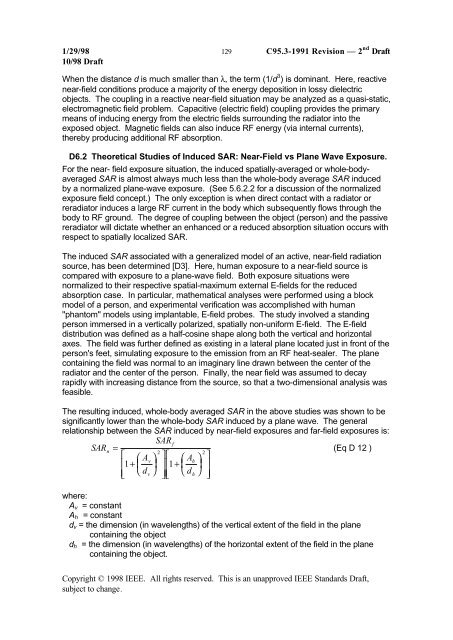DRAFT Recommended Practice for Measurements and ...
DRAFT Recommended Practice for Measurements and ...
DRAFT Recommended Practice for Measurements and ...
You also want an ePaper? Increase the reach of your titles
YUMPU automatically turns print PDFs into web optimized ePapers that Google loves.
1/29/98 129 C95.3-1991 Revision — 2 nd Draft<br />
10/98 Draft<br />
When the distance d is much smaller than λ, the term (1/d 3 ) is dominant. Here, reactive<br />
near-field conditions produce a majority of the energy deposition in lossy dielectric<br />
objects. The coupling in a reactive near-field situation may be analyzed as a quasi-static,<br />
electromagnetic field problem. Capacitive (electric field) coupling provides the primary<br />
means of inducing energy from the electric fields surrounding the radiator into the<br />
exposed object. Magnetic fields can also induce RF energy (via internal currents),<br />
thereby producing additional RF absorption.<br />
D6.2 Theoretical Studies of Induced SAR: Near-Field vs Plane Wave Exposure.<br />
For the near- field exposure situation, the induced spatially-averaged or whole-bodyaveraged<br />
SAR is almost always much less than the whole-body average SAR induced<br />
by a normalized plane-wave exposure. (See 5.6.2.2 <strong>for</strong> a discussion of the normalized<br />
exposure field concept.) The only exception is when direct contact with a radiator or<br />
reradiator induces a large RF current in the body which subsequently flows through the<br />
body to RF ground. The degree of coupling between the object (person) <strong>and</strong> the passive<br />
reradiator will dictate whether an enhanced or a reduced absorption situation occurs with<br />
respect to spatially localized SAR.<br />
The induced SAR associated with a generalized model of an active, near-field radiation<br />
source, has been determined [D3]. Here, human exposure to a near-field source is<br />
compared with exposure to a plane-wave field. Both exposure situations were<br />
normalized to their respective spatial-maximum external E-fields <strong>for</strong> the reduced<br />
absorption case. In particular, mathematical analyses were per<strong>for</strong>med using a block<br />
model of a person, <strong>and</strong> experimental verification was accomplished with human<br />
''phantom'' models using implantable, E-field probes. The study involved a st<strong>and</strong>ing<br />
person immersed in a vertically polarized, spatially non-uni<strong>for</strong>m E-field. The E-field<br />
distribution was defined as a half-cosine shape along both the vertical <strong>and</strong> horizontal<br />
axes. The field was further defined as existing in a lateral plane located just in front of the<br />
person's feet, simulating exposure to the emission from an RF heat-sealer. The plane<br />
containing the field was normal to an imaginary line drawn between the center of the<br />
radiator <strong>and</strong> the center of the person. Finally, the near field was assumed to decay<br />
rapidly with increasing distance from the source, so that a two-dimensional analysis was<br />
feasible.<br />
The resulting induced, whole-body averaged SAR in the above studies was shown to be<br />
significantly lower than the whole-body SAR induced by a plane wave. The general<br />
relationship between the SAR induced by near-field exposures <strong>and</strong> far-field exposures is:<br />
SARf<br />
SARn<br />
=<br />
(Eq D 12 )<br />
Av<br />
Ah<br />
+ ⎛ 2<br />
⎡<br />
⎝ ⎜ ⎞ ⎤<br />
⎢ ⎟ ⎥ + ⎛ 2<br />
⎡<br />
⎣⎢<br />
dv<br />
⎠<br />
⎦⎥<br />
⎝ ⎜ ⎞ ⎤<br />
1 ⎢1<br />
⎟ ⎥<br />
⎣⎢<br />
dh<br />
⎠<br />
⎦⎥<br />
where:<br />
A v = constant<br />
A h = constant<br />
d v = the dimension (in wavelengths) of the vertical extent of the field in the plane<br />
containing the object<br />
d h = the dimension (in wavelengths) of the horizontal extent of the field in the plane<br />
containing the object.<br />
Copyright © 1998 IEEE. All rights reserved. This is an unapproved IEEE St<strong>and</strong>ards Draft,<br />
subject to change.
















